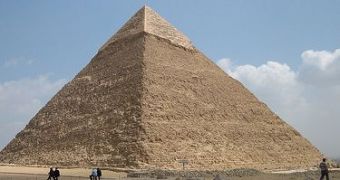Curiosity always takes over and it makes people discover new things, or new hidden old ones. Mysteries must be solved and the ones hidden inside the Pyramid of Khufu, also known as the Great Pyramid at Giza, might soon be at the end of their 4,500 year-old reign.
A robotics team from Leeds University, collaborating with Egypt's Supreme Council of Antiquities is working on a little robot that might succeed where everyone has failed: discovering the treasures at the heart of the monument, well protected by solid doors.
This pyramid was built around 2,560BC by the king Khufu and its construction is so ingenious that it remained a mystery for the last 4,500 years. At the center of the pyramid there are two rooms known as the King's Chamber and the Queen's Chamber. From the King's Chamber two shafts rise at 45-degree angles and lead to the exterior of the monument. They are supposed to be a passage for the king's spirit, so that it can reach its place among the stars.
Two other shafts were discovered in a1872, in the Queen's Chamber, but unlike those in the King's Chamber, they do not lead outside the pyramid. What frustrates scientists is that no one knows what these shafts are for. Back in 1992, a camera was sent up the shaft leading from the south wall of the Queen's Chamber and met a limestone door with two copper handles, 60 meters in depth. In 2002, another expedition drilled through the door and found a second one, 20 centimeters behind it.
Dr Zahi Hawass, head of the Supreme Council in charge of the expedition said that “the second door is unlike the first. It looks as if it is screening or covering something.” When exploring the north shaft, archaeologists found that it bends by 45 degrees after 18 meters but 60 meters further it is also blocked by a limestone door.
This new robot made at Leeds University could follow the shaft to its end, scientists hope. The project is called the Djedi project, after the magician that the king consulted before building the pyramid, and this robot should be able to drill through the second door and see what is hidden beyond. Anyway, the scientists are determined to continue the expedition, until they reach the end of the shafts, as Dr Robert Richardson, of the Leeds University School of Mechanical Engineering says.
“We have been working on the project for five years,” The Independent quotes. “We have no preconceptions. We are trying to gain evidence for other people to draw conclusions. There are two shafts. The north shaft is blocked by a limestone door and nothing has penetrated that door. With the south shaft a previous team has measured the thickness of the stone, drilled through it and put a camera through it and found there was another surface. We are going to determine how thick that is and we could drill through it. We are preparing the robot now and expect to send it up before the end of the year. It's a big question, and it's very important not to cause unnecessary damage. We will carry on until we find the answer. We hope to get all the data possible which will be sufficient to answer the questions.”
Still, nobody has asked the moral question: Is it ethical to drill through doors and see what's inside a tomb?

 14 DAY TRIAL //
14 DAY TRIAL //